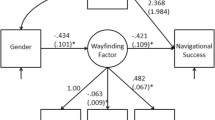Abstract
Differences between women and men in the self-reported use of two different way-finding strategies were examined in a sample of primarily white middle to lower middle class college undergraduates. Women were more likely to report using a route strategy (attending to instructions on how to get from place to place), whereas men were more likely to report using an orientation strategy (maintaining a sense of their own position in relation to environmental reference points). Women also reported higher levels of spatial anxiety, or anxiety about environmental navigation, than did men. The orientation strategy was found to be positively correlated with spatial perception ability and negatively correlated with spatial anxiety.
Similar content being viewed by others
References
Baenninger, M., & Newcombe, N. (1989). The role of experience in spatial test performance: A meta-analysis.Sex Roles, 20 327–344.
Beatty, W. W., & Tröster, A. I. (1987). Gender differences in geographical knowledge.Sex Roles, 16 565–590.
Bever, T. (1992). The logical and extrinsic sources of modularity. In M. Gunnar & M. Maratosos (Eds.),Modularity and constraints in language and cognition, 25, Minnesota Symposia on Child Psychology, 1992. Hillsdale, NJ: Lawrence Erlbaum.
Binet, M. A. (1894). Reverse illusions of orientation.The Psychological Review, 1 337–350.
Bronzaft, A. L., Dobrow, S. B., & O'Hanlon, T. J. (1976). Spatial orientation in a subway system.Environment and Behavior, 8 575–594.
Bryant, K. J. (1982). Personality correlates of sense of direction and geographical orientation.Journal of Personality and Social Psychology, 43 1318–1324.
Casey, M. B., & Brabeck, M. M. (1990). Women who excel on a spatial task: Proposed genetic and environmental factors.Brain and Cognition, 12 73–84.
Clarkson-Smith, L., & Halpern, D. (1983). Can age-related deficits in spatial memory be attenuated through the use of verbal coding?Experimental Aging Research, 9 179–184.
Cohen, S. L., & Cohen, R. (1985). The role of activity in spatial cognition. In R. Cohen (Ed.),The development of spatial cognition. Hillsdale, NJ: Lawrence Erlbaum.
Devlin, A. S. (1973). Some factors in enhancing knowledge of a natural area. In W. F. E. Preiser (Ed.),Environmental design research (Vol. 2). Stroudsburg, PA: Dowden, Hutchinson & Ross.
Evans, G. W. (1980). Environmental cognition.Psychological Bulletin, 88 259–287.
Evans, G. W., Skorpanich, M. A., Gärling, T., Bryant, K. J., & Bresolin, B. (1984). The effects of pathway configuration, landmarks and stress on environmental cognition.Journal of Environmental Psychology, 4 323–335.
Feingold, A. (1988). Cognitive gender differences are disappearing.American Psychologist, 43 95–103.
Gärling, T., Böök, A., & Lindberg, E. (1985). Adults' memory representations of the spatial properties of their everyday physical environment. In R. Cohen (Ed.),The development of spatial cognition. Hillsdale, NJ: Lawrence Erlbaum.
Gregg, F. M. (1940). Overcoming geographic disorientation.Journal of Consulting Psychology, 4 66–68.
Harris, L. J. (1981). Sex-related variations in spatial skill. In L. S. Liben, A. H. Patterson, & N. Newcombe (Eds.),Spatial representation and behavior across the life span. New York: Academic Press.
Hart, R. (1979).Children's experience of place. New York: Irvington.
Kozlowski, L. T., & Bryant, K. J. (1977). Sense of direction, spatial orientation, and cognitive maps.Journal of Experimental Psychology: Human Perception and Performance, 3 590–598.
LaGrone, C. W. (1969). Sex and personality differences in relation to feeling for direction.The Journal of General Psychology, 81 23–33.
Linn, M. C., & Petersen, A. C. (1985). Emergence and characterization of sex differences in spatial ability: A meta-analysis.Child Development, 56 1479–1498.
Maccoby, E. E., & Jacklin, C. (1974).The psychology of sex differences. Stanford, CA: Stanford University Press.
Nerlove, S. B., Munroe, R. H., & Munroe, R. L. (1971). Effect of environmental experience on spatial ability: A replication.The Journal of Social Psychology, 84 3–10.
Newcombe, N., & Dubas, J. S. (1992). A longitudinal study of predictors of spatial ability in adolescent females.Child Development, 63 37–46.
O'Keefe, J., & Nadel, L. (1978). Spatial behaviour.The hippocampus as a cognitive map. Oxford Clarendon Press.
Robert, M., & Tanguay, M. (1990). Perception and representation of the Euclidean coordinates in mature and elderly men and women.Experimental Aging Research, 16 123–131.
Russell, J. A., & Ward, L. M. (1982). Environmental psychology.Annual Review of Psychology, 33 651–688.
Saegert, S., Mackintosh, I., & West, S. (1975). Two studies of crowding in urban public spaces.Environment and Behavior, 7 159–184.
Sholl, M. J. (1989). The relation between horizontality and rod-and-frame and vestibular navigational performance.Journal of Experimental Psychology: Learning, Memory, and Cognition, 15 110–125.
Siegel, A. W., & White, S. H. (1975). The development of spatial representations of large-scale environments. In H. W. Reese (Ed.),Advances in child development (Vol. 10). New York: Academic Press.
Signorella, M. L., Jamison, W., & Krupa, M. H. (1989). Predicting spatial performance from gender stereotyping in activity preferences and in self-concept.Developmental Psychology, 25 89–95.
Trowbridge, C. C. (1913). On fundamental methods of orientation and “imaginary maps.”Science, 38 888–897.
Vandenberg, S. G., & Kuse, A. R. (1978). Mental rotations, a group test of three-dimensional spatial visualization.Perceptual and Motor Skills, 47 599–604.
White, R. W. (1959). Motivation reconsidered: The concept of competence.Psychological Review, 66 297–333.
Williams, C. L., Barnett, A. M., & Meck, W. H. (1990). Organizational effects of early gonadal secretions on sexual differentiation in spatial memory.Behavioral Neuroscience, 104 84–97.
Wittig, M. A., & Allen, M. J. (1984). Measurement of adult performance on Piaget's water horizontality task.Intelligence, 8 305–313.
Zimring, C. M. (1981). Stress and the designed environment.Journal of Social Issues, 37 145–171.
Author information
Authors and Affiliations
Rights and permissions
About this article
Cite this article
Lawton, C.A. Gender differences in way-finding strategies: Relationship to spatial ability and spatial anxiety. Sex Roles 30, 765–779 (1994). https://doi.org/10.1007/BF01544230
Issue Date:
DOI: https://doi.org/10.1007/BF01544230




